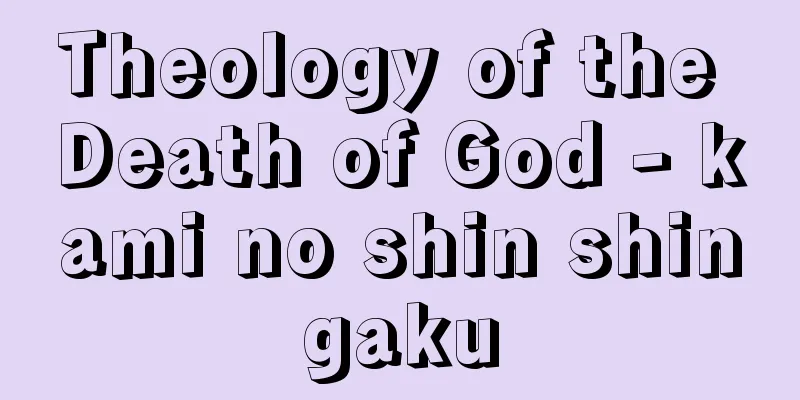Theology of the Death of God - kami no shin shingaku

|
Theology that takes the position that God is dead, especially in addressing the issue of secularization. Anti-Christian philosopher Nietzsche spoke about the death of God, but it was in the 1960s in America that theologians who spoke about the death of God appeared. First, Vahanian, who wrote a book titled The Death of God (1961), defined the modern age as the "age after the death of God" because God is only a cultural accessory or idea for modern people. Next, Van Buren wrote The Secular Meaning of the Gospel (1963) and spoke about the death of the word "God." Because the proposition of God is unprovable, it is meaningless to use the word. Furthermore, Cox, author of The Secular City (1965), argued that the God of American society, which tolerates racial discrimination, is dead, or rather, that he is a God who should die. Hamilton and Altizer, who published Radical Theology and the Death of God (1966), took up the cultural, linguistic, and social death of God as an existential and theological theme. Hamilton spoke of the existential experience of the absence of God from the tragedies of Auschwitz and Hiroshima during World War II that he and the modern world experienced, and concluded that the only way to overcome it is to practice love. Altizer interpreted the death of Christ on the cross as the death of God, and that this was the gospel that the transcendent God had died and was now immanent in the human world and history, and was present in its suffering. The popularity of this theology ended in the 1960s, but there were many contributions that presented unavoidable issues as the problem of God in the modern world. [Yasuo Furuya] Source: Shogakukan Encyclopedia Nipponica About Encyclopedia Nipponica Information | Legend |
|
とくに世俗化の問題との取り組みにおいて、神は死んだという立場にたつ神学。神の死について反キリスト教の哲学者ニーチェは語ったが、神の死について語る神学者が出現したのは、1960年代のアメリカである。最初に『神の死』(1961)という題名の書物を著したバハニアンは、現代人にとって神は文化的アクセサリーか観念でしかないために、現代は「神の死後の時代」であると規定した。ついでバン・ビューレンは『福音(ふくいん)の世俗的意味』(1963)を書き、「神」という言語の死について語った。神という命題は証明不可能であるがゆえに、そのことばを用いることは無意味であるからである。さらに『世俗的都市』(1965)の著者コックスは、人種差別を容認しているアメリカ社会の神は死んでいる、いや死ぬべき神であると主張した。これらの文化的、言語的、社会的な意味での神の死を実存的かつ神学的な主題としたのは、共著で『過激な神学と神の死』(1966)を出版したハミルトンとアルタイザーである。ハミルトンは、彼自身と現代世界が体験した第二次世界大戦のアウシュウィッツやヒロシマの悲劇から神不在の実存的経験について語り、それを超えるものとしては愛の実践しかないと結論した。アルタイザーは十字架上のキリストの死こそは神の死であり、それは超越的な神が死んで人間世界と歴史のなかに内在し、その苦難のなかにいたもうという福音であると解釈した。この神学の流行は60年代で終わったが、現代における神の問題として不可避の課題を提示した貢献は少なくない。 [古屋安雄] 出典 小学館 日本大百科全書(ニッポニカ)日本大百科全書(ニッポニカ)について 情報 | 凡例 |
<<: God's Rule - Kami no Shihai
Recommend
Raymond, HJ
…It is known as a high-quality paper. It was plan...
Long live Iroku
...It is said that Manzai was performed at the Im...
Huang Binhong (Huang Binhong)
1865‐1955 A contemporary Chinese painter. His give...
Heterocercal tail
…The scales are tiny, but have a hard enamel-like...
Telegram - denpo (English spelling) telegram
A service in which communication content is trans...
Maluku
…the name of the numerous islands scattered betwe...
cicatricial hernia
…Epigastric hernias occur in the weak areas of th...
Hemera (English spelling)
…First came Chaos, the void, then Gaia (earth) an...
time charter
…In the broad sense, chartering refers to both th...
Inclination
...In mathematics, gradient is defined and used a...
Street performance - daidōgei
It is a general term for street entertainment in ...
Earth rhythm - Earth rhythm
A term related to rhythm in Noh. It is a method of...
"Every month of the lightning field" - Every month of the lightning field
...The people were very hostile towards the tyran...
Jiangnan Army
A faction of the Yuan army, consisting mainly of s...
Dry paper mold - Kanshikishikei
…Usually, a material called a stencil paper is pl...









